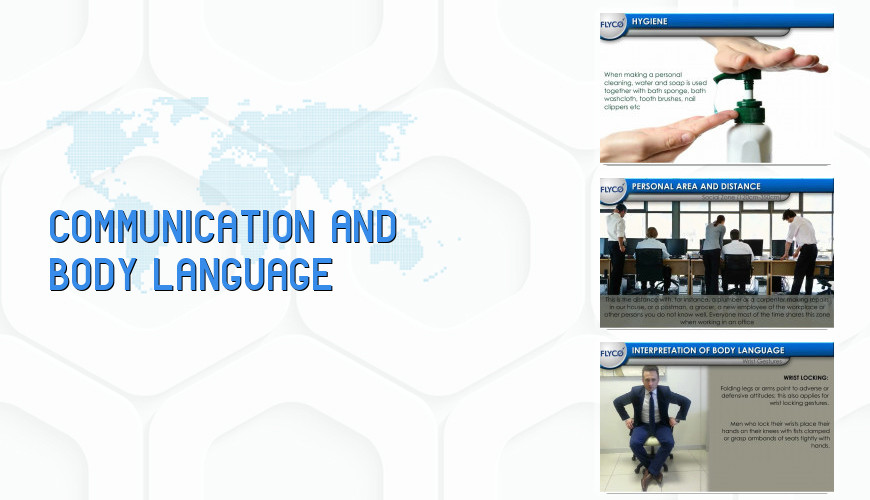
Course Information
Welcome to our training about Communication and Body Language. The objective of this training session is to provide you with information about the following subjects: Communication skills and effective listening, emotional intelligence and empathy, stress management and anger control, body language, intonation, analytical thinking and passenger satisfaction.
Content of the Course
| Slide | 112 | Duration | 01:10:30 | Exam | Yes |
|---|
- COURSE START
- COMMUNICATION AND BODY LANGUAGE – OBJECTIVE OF THE TRAINING
- What is communication?
- Why is communication important?
- First impression:
- Feeling of trust
- Untrusty attitudes – Speaking too much and making too many remarks
- Providing too many excuses regarding one issue
- Elements of communication process
- Types of communication – Interpersonal communication
- Intrapersonal communication
- VERBAL COMMUNICATION – EFFECTIVE LISTENING AND EFFECTIVE FEEDBACK
- COMMUNICATION SKILLS AND EFFECTIVE LISTENING
- The art of efficient listening
- Good listener
- Efficient feedback
- Complicated communication factors
- Giving orders
- Threatening – Always giving warnings
- Going off on a tangent – Judging, criticing or blaming one
- Instructing and disserting – Interpretation and diagnosis
- Name-calling, teasing
- EMOTIONAL INTELLIGENCE AND EMPATHY – WHAT IS EMOTIONAL INTELLIGENCE?
- Constructs of emotional intelligence – Self-awareness
- Self-regulation
- Motivation
- Emphaty
- Benefits of empathy
- Social skill
- EMOTIONAL INTELLIGENCE – EQ AND IQ
- ANGER CONTROL AND STRESS MANAGEMENT – WHAT IS ANGER?
- Is Anger abnormal?
- Is Relief of anger (rage) good?
- Examples from our everyday life
- When do we get angry?
- Why do we get angry?
- Types of anger expression
- I Language and you language
- You Language and i language – drills
- Things to do
- What is stress?
- Are All of stresses harmful?
- Signs of stress
- Coping with stress
- BODY LANGUAGE
- Elements of body language
- Difference of gestures and mimics:
- Mimics
- INTERPRETATION OF BODY LANGUAGE
- Head positions
- Both hands behind the head
- Arms folded – Arms partly folded
- Wrist gestures – Wrist locking – Leg wrist locking
- Hand and arm gestures – Mouth closure – The nose touch – Chin stroking – Evaluation gesture
- Neck-head scratching – Boredom gesture – Picking imaginary lint
- Roof top/down hand gestures
- PERSONAL AREA AND DISTANCE
- HYGIENE
- Hand and nail cleaning and care
- Face and mouth hygiene
- Hair cleanliness and care
- Bathing and armpit hygiene
- CLOTHING HYGIENE AND CARE
- Other requirements
- TONE COLOR AND INTONATION – INTONATION
- ANALYTICAL THINKING
- What is a problem?
- Problem solving
- PASSENGER SATISFACTION
- Expectations of passengers
- Service industry
- Unfavorable expressions
- What we need to avoid doing
- Angry passengers
- Do Not use a jargon – Gain trust
- Do Not forget the humanistic side
- What we need to do
- When keeping passengers waiting
- Reconciliatory language
- Approval
- TIPS ON PHONE CONVERSATIONS
- KEY WORDS USED ON THE PHONE
- HOW IS SATISFACTION GAINED THROUGH THE PHONE?
- WHAT MUST YOU DO UNDER ADVERSE CONDITIONS?
- COMMUNICATION WITH SUPERORDINATES AND – SUBORDINATES AT A WORKPLACE
- PASSENGER COMPLAINTS – WHAT IS A COMPLAINT?
- Empathy at the time of a complaint
- How do we need to response to complaints?
- COURSE END

